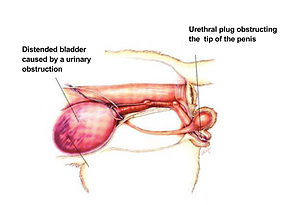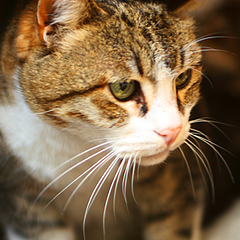Feline Lower Urinary Tract Disease (FLUTD) describes the one or more from the following group of clinical signs:
- Bloody urine
- Straining and/or pain when urinating
- Urinating in unusual places
- Urinary blockage
- Over grooming the external genitals
These symptoms can occur as an isolated incident, however, many cats with FLUTD will have recurrent urinary problems throughout their lives.
The cause of this disease is variable, but can include:
- Stress, urinary tract infection
- Crystals in the urine
- Bladder stones
- Urinary tract cancer or polyps
- Trauma to the urinary tract
Diagnostic testing is important in helping sort out the cause of the urinary symptoms. These tests often include:
- Blood testing (to rule out kidney disease)
- Urinalysis
- Urine culture (to determine the type of bacteria present and which antibiotic will work best to treat it)
- Ultrasound and/or x-ray of the urinary tract
In 50% of the cases, a cause cannot be determined despite extensive testing, this clinical syndrome is called “idiopathic cystitis.”
Treatment is based on the cause. In cases of “idiopathic cystitis” many modalities may be used through trial-and-error to control symptoms but a cure can be difficult to achieve.
Common treatments for specific ailments include:
- Urinary infections are treated with antibiotics
- Crystals in the urine are treated with diet change
- Painful urination is treated with anti-inflammatory of pain relieving medications
- Bladder stones are treated with surgical removal
- Stress can be managed with pheromones, diet change, behavior modification and medications.
 Urinary Obstruction/Blockage
Urinary Obstruction/Blockage
Male cats experiencing lower urinary tract disease are uniquely at risk for a life threatening complication of this syndrome – urinary obstruction. Blood, crystals, stones and mucus can form a plug that clogs the narrow male urethra preventing urine from passing. If this blockage persists, it can lead to bladder rupture or changes in the blood that can result in severe illness or death.
Initial treatment involves placing a urinary catheter under sedation/anesthesia to allow the bladder to empty. The urinary catheter may be left within the urethra for continued urine passage for 24-48 hours allowing for treatment of the inciting cause.
Cats that have had a urinary obstruction will be at significantly higher risk of re-blocking in the future. Some male cats with frequent incidence of urinary blockage will be advised to undergo a surgical reconstruction of the genitalia to create a more female-like opening to allow for easier passage of urine. This surgery is called a perineal urethrostomy (or “PU” for short). If this procedure is needed, your veterinarian will discuss the details of this procedure with you.

